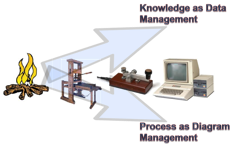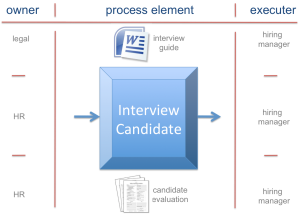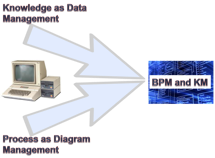 Knowledge management and business process management are often considered two distinct disciplines. It wasn?t always that way. Over time, the two domains have separated and it has been to the detriment of business. This is how it happened and why it needs to be fixed.
Knowledge management and business process management are often considered two distinct disciplines. It wasn?t always that way. Over time, the two domains have separated and it has been to the detriment of business. This is how it happened and why it needs to be fixed.
Definitions
A significant challenge of any discussion of business process or knowledge management is agreement on definition of the two terms. There are disparate views of KM and BPM, mostly depending on the definer?s role in the organization. A great deal of time and effort is wasted as IT and business struggle to understand each other?s vocabulary and needs. In fact, the two sides are often so far apart that it creates distrust and cynicism that prevents real cooperation where it matters most. Software and solution vendors contribute to the problem by solving one side?s problems but ignoring the other?s. Knowing this, it would be appropriate to start with these definitions of both BPM and KM.
Business process management (BPM) ? BPM is a systematic approach to improving a company?s business processes. For example, a BPM application could monitor receiving systems for missing items, or walk an employee through steps to troubleshoot why an order did not arrive. [1]
Knowledge management (KM) ? KM is the process through which organizations generate value from their intellectual and knowledge-based assets. Most often, generating value from such assets involves codifying what employees, partners and customers know, and sharing that information among employees, departments and even with other companies in an effort to devise best practices. [2]
What?s very important to point out about these definitions is that technology may be used as an example of ?modern? BPM and KM; but technology in itself does not define the two areas. One of the primary reasons there are so many ways to describe BPM and KM relates to this one problem?that technology for so long been so much a part of the solution that it often sounds like the solution itself. A look back into the past tells a different story.
Early History
Process and knowledge have always been with us and were initially very closely linked. When early cavemen decided to build a fire, they had a process that combined knowledge of the materials and the process for doing so. Starting with small pieces of wood was certainly part of their process, but so was the knowledge that wood needed to be dry. Process and knowledge were passed verbally or through gestures and were dependent upon each other. They were inseparable, in fact. The earliest purveyors of ?survival? process (before it became ?business?) and knowledge management had a joined-up system for managing the two and it worked because it had to.

Figure 1. Process and knowledge in combination
Automation
As societies progressed and written language developed, knowledge management and business process management became a physical library of information?things that could be written down. And they were written by hand, one at a time, by the few that had the resources and education to do so. Describing a process was no harder than depicting knowledge, and just as automated. Both concepts continued to have equal footing until real changes arrived with the
ability to store and retrieve information. Starting with the printing press, systems to store letters (and therefore words) and numbers were the first to become automated and commercially viable. Moveable type was well suited to knowledge and not suited to diagrams. Knowledge Management surged ahead of business process because it was easier and more rewarding to focus on what technology could make easy to manage.

Figure 2. Printing press accelerated knowledge management
Further technology changes drove the two communities of practice apart even more and with a greater benefit for knowledge management. It was easier to store and transmit words and numbers first in moveable type through the printing press and continuing with each progressive technology advance from the telegraph to the typewriter to the computer. Linear combinations of a limited set of symbols conveyed information in a simple, streamlined manner as data. Every?advance in moving knowledge as data made focusing on knowledge data more and more attractive. Moveable type was fantastic for capturing words, so we evolved standard operating procedures and extensive manuals describing process, which later became intranets, knowledge portals and the like; each was a static, written representation of business activity.
Eventually, technology advanced and systems were created to store process as visual depictions, but only relatively recently. These first systems reflected the lack of emphasis that history had dealt to business process management and initial process systems didn?t include data centralization in any meaningful way. Our focus stayed where the experience and success had been; with KM, where by this point, a string of characters could be written to or retrieved as a record in a centralized database. Our society found success in business without process and knowledge in a single system and it was acceptable to keep them separate even after the?technology arrived that would enable their re-merge.
Simply put, knowledge had long ago become discreet elements of data while process was trapped in documents. Before technology separated the two, the ability to communicate process was on par with knowledge and contained jointly in one of the earliest KM/BPM systems: The human brain. From that point forward, technology played favorites and advanced the cause of knowledge far more than process.

Figure 3. Technology creates different paths for KM and BPM
The KM system
The 2000?s have been the years of the portal, with company after company buying similar technology as a way to better communicate knowledge throughout the organization. The thought was that better paths for communication of knowledge and an appropriate level of end user engagement would translate somehow to better profitability. The first problem that arises from this thinking is in defining the goals of such a system. ?The traditional KM justification has been around activity measures; the more people talk to each other, or the more people hit the lessons learned website. Many call centers have a metric for calls to be picked up in 2 versus 3 rings.? Says Jim Lee, Knowledge Management Practice Director at APQC. These measures are used as a way to build the case for a system and then to establish its value once up and running. Jim goes on to say, ?Measures aside, there is little downside to knowledge sharing with the exception of a WikiLeaks-type scenario.?
The second problem that arises is in finding that ?appropriate level of end user engagement?. Most portals launch with early signs of success but over time their use and effectiveness drop considerably. In the worst cases, suggesting that a user go to a portal to find key information results in groans and eye rolls as cynicism pervades the user base.
Looking at the direction software vendors are going (including portal vendors), having a portal for?purely Knowledge Management purposes is a dying concept.
The BPMS
BPM in the computer era started as point solutions that either manage the human-to-human or?automated workflow activities. Just like having a one-sided definition of BPM or KM, those point?solutions failed to deliver to everyone?s expectations. ?Much of the difference between KM and?BPM had been artificially driven by vendors selling specialized technologies within each?category,? says Diana Davis, Editor, PEX Network. ?That made sense in the early days of process?automation and technology development because as a vendor you can?t invent an all singing, all?dancing solution on your first attempt.?
There have been an enormous number of consolidations in the BPM space over the past several?years as each vendor seeks to find a platform solution, or BPMS. [3] These acquisitions reflect?acknowledgement that there is more to BPM than has been addressed by the BPM systems of?the past. There is a growing school of thought that BPM of the future involves process?management in a consistent, change-managed fashion throughout its entire lifecycle. The recent?flurry of acquisitions in the BPM market, Davis adds, shows that there is growing recognition by?technology vendors that all ?these pieces are part of a larger puzzle.? This approach describes?BPM as a platform.
Re-merging of KM and BPM
We are now entering the post-portal age where the cynicism generated by past KM and BPM?failures means that a thoughtful solution must have wide acceptance by both the business and?technology parts of the organization.
Figure 4. KM and BPM re-merge with new technology
Beyond cynicism as a driver, new ways of looking at process as data to be owned, changed, and?communicated from a central database makes the management of process as easy as the?management of knowledge. Just as knowledge was once managed inside documents, process?data is coming out of isolation in documents and the newest generation of software maintains?knowledge and process side by side.
These changes offer a new way of doing business that is broader than traditional process or?knowledge management. It even offers new life for continuous improvement techniques that?lacked strong technology backing in the past. Diana explains, ?A disciplined process?management approach is evolving and putting a greater emphasis on combining different?disciplines like Lean, Six Sigma and knowledge management. As you automate, you must be?analyzing and improving before you hardwire through automation.? The line between process,?knowledge, and continuous improvement is hard to find.
Working Contextually
The real significance of the KM and BPM together means that just as in the early days of making?fire, both process and knowledge are in the proper context. The right information is in the hands?of the right individual at the right moment for work to be accomplished in the best way possible.
This gets very interesting when people can tap into both the knowledge and diagrams that?support a process while they are actually engaged in carrying out business activity. When they?can do that knowing they?re working with latest, greatest version of that information, you have?highly efficient behavior and workers who are liberated from confusion, doubt and time-wasting?searches.

Figure 5. KM and BPM in context
Apart from the execution of process and knowledge, the reunified technologies allow the best approach for analysis of existing data and for figuring out what is broken, how it can be fixed, and the knowledge and process necessary to do it: Using knowledge to refine the process of process. Jim Lee points out; ?We can?t help an organization with knowledge sharing until we know what process they are trying to do better. Working with a large shipbuilder, we found that we started off?with process mapping. They often had wildly divergent ways of conducting process. After we mapped, the next question became, ?What kind of knowledge is necessary to improve this process or to even do it correctly.??
After all, what is the point of having knowledge in business if it isn?t to accomplish some sort of?work? Unless we?re in the quiz show business, the possession of knowledge without work activities where that knowledge matters isn?t of value.
Being Social
In the midst of the technology changes that bring KM and BPM together, social media brings knowledge to process in a less structured way. Any system approach to KM and BPM must have structure for the M (management) to be effective. The danger of structure is that it by natures doesn?t allow for the unexpected or unforeseen. The reach of a social system combined with the structure of BPM and KM means that the unforeseen knowledge need has a much higher?potential to be answered by the unexpected resource.
Suddenly requirements are no longer ?the need to figure out every deliverable before we start?. Unstructured, consistent input from a wide variety of contributors means that the knowledge and process we start with can quickly become the process and knowledge we ?really? need and use today and as it changes over time.

Figure 6. The social dimension
At this point, ownership becomes a critical part of the BPM/KM/Social system. Without ownership,?everyone is an expert and no one is responsible. This translates to a need for clear ownership of?the results of a process and ownership of key elements of knowledge where the activity and its?outcome are regulated, certified or safety-involved, but also where the outcome is measured as in?sales or customer service. Ownership and change management are the safeguards preventing?chaos and entropy.
As Diana explains, ?The ?Now Generation? expects communication to be instant. People don?t?expect to wait for answers. Not so long ago it could take days or weeks to correspond through the?post and we learned a certain kind of patience as a result. Now the expectation is that we can find?the answers ourselves, instantly.? These expectations are only increasing as the next generation?enters the workforce, unaware of a world before Google and Facebook.
Social isn?t new but the way to enable it certainly is. From Diana?s perspective, ?In the past we?had ideas for how KM and BPM should work together but didn?t have the technologies to enable?it. As technology has evolved and social media has been widely adopted, the ability to?communicate knowledge at a particular point in the process has become possible by everyone?within the organization and not just a specialized few.? This potentially disruptive to power?structures, especially in traditional hierarchical work environments. Diana continues, ?Social has?upped the ante but I think we?re still at very early stages of learning to use it effectively within?companies.?
Going Mobile
There is enormous change going on with the concepts discussed so far, but it all comes into stark?relief against the accelerating trend toward mobile platforms for process and knowledge capture,?consumption and change management. So many of the ?apps? that are being released for various?smartphone and tablet devices are taking advantage of functionality that pulls together many?pieces of data without forcing the user to move between systems. No longer are users forced into?multiple windows and toggling between applications to find what is needed. To be of value, data?needs to be assembled and presented to the user in the most efficient form possible. And, of?course, in context of their work.
There are already mobile apps on the market that bring together knowledge and process in a?single, tight interface and it will be only a matter of time before the desktop is viewed as the place?where content is created and managed, and the mobile device is where content is consumed and?also managed. It wouldn?t be an enormous leap to see the tablet as the place where content can?also be created, meaning that a process workshop can be anywhere and not just a conference?room.
Conclusion
Knowledge is an equal partner of business process. All of the knowledge in the world won?t make?something happen; it has to be acted upon?as process. Likewise, all of the process steps in the?world without appropriate knowledge are out-of-context activities without direction. Not only have?knowledge and process already reunited in many environments, it is a fair statement to say that?an environment where knowledge and process are managed separately is quickly becoming?outdated and wont be competitive against organizations that empower their people with reunited?KM and BPM.
References
[1] Business Process Management (BPM) Definition and Solutions, Mark Cooper, CIO Magazine,
April 27, 2007
[2] Knowledge Management Definition and Solutions, Meredith Levinson, CIO Magazine
[3] Gartner Sees Strong Growth, Vendor Consolidation In BPM Market, Antone Gonsalves,
Information Week, March 27, 2007
Like this:
Be the first to like this.
bane Aurora Colorado Rajesh Khanna friday the 13th paulina gretzky paulina gretzky toy story 4

No comments:
Post a Comment
Note: Only a member of this blog may post a comment.